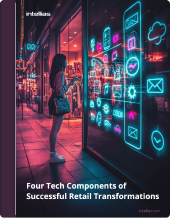The rapid adoption of cloud computing technologies will continue defining leaders and losers across many industries in the coming years, and especially in eCommerce, where speed and downtime are critical. Cloud eCommerce will become a solid framework for the adoption of next-gen technologies like deep learning, quantum algorithms, and advanced visualization.
According to Gartner’s November forecast, the revenues of public cloud services alone will grow by 81.2% within the five years from 2018 till 2022, reaching $354.6 billion. Given the new normal of the post-COVID era, this estimate might as well be on the modest side.
Worldwide public cloud service revenue forecast (billions of US dollars)

Source: Gartner’s Worldwide Public Cloud Service Revenue Forecast
The development of cloud services is changing lightning fast due to their relative novelty and game-changing investment potential. Here’s a snapshot of the current state of cloud services and the latest best practices for cloud-based eCommerce.
Read on to learn more about:
- The power of eCommerce cloud computing
- The architecture of eCommerce cloud services
- The good and the bad of eCommerce cloud
- How retailers lose out without a cloud-based eCommerce infrastructure: Insightful use cases
- Consult an expert in eCommerce cloud software development for peace of mind
The power of eCommerce cloud computing
Cloud technology has proven an invaluable asset for the evolution of eCommerce, specifically for the SMB segment. While bigger corporations may have no issues buying and maintaining their own data centers, smaller players are looking for every opportunity to keep their costs down and evenly distributed.
Due to the pay-as-you-go model of many cloud storage services, no large upfront investments are required from eCommerce businesses. At the same time, these businesses can address many pain points and get access to as much server capacity as they need at any given time.
eCommerce cloud computing plays an important role in the following enterprise-level functions:
- Big data analytics
- Email storage
- Data backups
- Virtual desktops
- Development of web applications
- Disaster recovery
- Software development and testing
Apart from the cost-efficiency of using this relatively novel technology from cloud providers (as opposed to buying expensive hardware and maintaining physical data centers), a cloud-based eCommerce model also brings agility, scalability, and business continuity.
According to the Page Speed Loading report by Unbounce, page speed impacts willingness to buy for 70% of users. Moreover, over a quarter of users will give up on a website that takes more than three seconds to load, while another third will wait up to six seconds.
Users won’t wait long for the page to load

Source: Unbounce – Page Speed Report
This fact alone is the best sales pitch for any cloud services provider, as speed essentially equals sales in the online shopping realm.
What is journey-driven retail?

Source: Journey-driven retail by AWS
The architecture of eCommerce cloud services
The Deloitte Tech Trends 2020 Report sums up the importance of cloud technology in this colorful statement so perfectly that we can’t help but share it with you: Cloud is absolutely an evolution of essential mainframe concepts, from logical partitioning to distributed storage to virtualization. It represents advances in standardized data transmission, network protocols, grid computing, multi-tenant resource pooling, identity and access management, dynamic provisioning, measured services […], at scales historically unimaginable, at price points that would have been unthinkable.
Flowery metaphors aside, eCommerce cloud computing solutions have a complex multi-layered architecture that’s rather technical. It usually includes:
- Hardware resources
- Software resources
- Resource management
- Servers
- Business layers
Cloud computing is categorized according to the deployment method and service model. The choice of deployment model depends on the objectives pursued by an enterprise, funds available, budget restraints, and security requirements. The more sensitive the data to be processed, the more chances a company will opt to invest funds and lean towards a private or hybrid deployment method.
Data with low levels of sensitivity but that requires significant levels of processing and computation is better deployed on a public cloud.
There’s an industry consensus that hybrid cloud computing is going to be the number one choice going forward in cloud-based eCommerce, as it allows for vendor flexibility as well as segregated use of clouds for sensitive and non-sensitive data streams.
Even though private computing requires substantial capital investment and higher monthly payments, it’s usually cheaper than independently purchasing and maintaining servers.
Deployment models
Private
One company servicing one or multiple clients with an on- or off-premises deployment. The deployment is not shared with the public but rather with a limited number of contracted clients. This type of deployment offers strong security, so it’s great for a cloud-based eCommerce platform or application with sensitive information. A private cloud can be accessed via the internet as well as within private networks.
Public
The public cloud deployment model involves the use of free or paid cloud technology provided by a third party to the general public or to an unlimited number of clients. Any activity performed by an internet user online is affiliated with the use of the public cloud in one way or another. The disadvantages this model brings to cloud eCommers are a lack of security, vendor lock-in, and limited control.
Hybrid
The above mentioned disadvantages of the public cloud are addressed by the hybrid cloud, which is a combination of private and public cloud environments; a private cloud is used for processing and storing sensitive data while a public cloud is employed for volume-related processes with minor sensitivity. A hybrid cloud setup also allows you to avoid vendor lock-in by distributing data between the hybrid clouds of several providers.
Community
A community cloud is more akin to a private cloud model but with clients being restricted to a single community with similar regulations or a similar legal framework — for example, a healthcare sector community cloud deployment.
Cloud service models: IaaS, PaaS, SaaS
Cloud service models define which elements go into the cloud service. Let’s use a pancake metaphor to describe how this works.
There are different ways you can make pancakes for breakfast. You can buy flour, eggs, sugar, and milk, mix them, and cook the pancakes to your liking. Alternatively, you can purchase a pancake mix, add water to it, and simply cook. In this case, you don’t need to know how many eggs and how much sugar or milk go into the recipe. It’s been taken care of by the chefs. Finally, you can order fresh pancakes from the nearest diner. This is likely to take the least time — and could also be the tastiest option.
Similarly, different eCommerce cloud service models allow users to choose how many service elements they’re ready to take responsibility for and how many they want to pay somebody else to take care of.
The IaaS model only provides the infrastructure; SaaS is a full package that requires minimal involvement by the client and offers infrastructure, platform, and software tools; PaaS is in between, like the pancake mix.
Infrastructure as a Service — IaaS
In this cloud eCommerce model, a cloud provider only supplies limited basic services like storage and virtual machines while the user is responsible for data, runtime, middleware, applications, and the operating system.
Platform as a Service — PaaS
This service model is often used for developing, testing, and managing applications, as the user is only required to handle applications and data while the rest of the architecture is taken care of by the service provider.
Software as a Service — SaaS
In this model, all components of the cloud-based eCommerce platform or application are handled by the cloud vendor, which is ideal for companies that want nothing to do with IT equipment altogether.
The good and the bad of eCommerce cloud
May the advantages of eCommerce cloud solutions come first here.
-
Cost efficiency
Among the top pluses of cloud eCommerce businesses using outsourced server capacity and databases is the cost savings. Bardia Dejban, the CEO of Volusion, shares that the company managed to save 37% in monthly costs after transferring data to the Google Cloud Platform.
For SMB eCommerce, significant upfront payments for hardware are insurmountable, so having a pay-as-you-go model with monthly payments is ideal for many players.
-
Speed
In the same presentation, Volusion reports a massive 65% average increase in the first byte response time metric for all its clients after switching to Google Cloud Platform. In an environment as sensitive to loading time as eCommerce, this translates into increased revenue.
-
Scalability
There may be different reasons for peak traffic going to your online store. You may have had a viral influencer campaign or quickly grown a massive following with a successful launch campaign, or you may have hit the sweet pricing spot in the holiday shopping craze.
Whatever the case, your expensive marketing team has worked hard to achieve this traffic. The worst thing is for your servers to not be able to handle it and collapse on you, resulting in hundreds of thousands of dollars in lost potential revenue.
eCommerce cloud computing allows companies to consume server capacity as they need it — only paying for what they have used.
Public cloud development and infrastructure platforms — The Forrester Wave™

Source: Forrester – Public Cloud Development and Infrastructure Platforms, North America, Q1 2020
Advantages noted. And what’s at risk when relying on cloud eCommerce?
There are two main pitfalls when it comes to eCommerce cloud computing combo:
- Dependence on internet access. If there’s an internet failure, you’re locked from managing your data.
- Dependence on the provider. If something happens on the side of the cloud services provider, you have little control over it.
Both these risks are minimal in developed countries, particularly if reliable cloud vendors are considered.
How retailers lose out without a cloud-based eCommerce infrastructure: Insightful use cases
Most losses related to server performance and database management happen alongside the biggest opportunities: during peak demand.
E-tailers will unknowingly lose in most cases when slow page loading makes their clients leave the site. Some of these losses are experienced during peak demand, like on Black Friday, when even eCommerce giants like Macy’s and Lowe’s report technical glitches related to over-capacity.
On the other hand, you have examples like Shop Direct, one of the major UK retailers, who managed to increase their orders per hour to 10,000 during Black Friday across just one of their brands while previously hitting a max of 8,000 for all six of their brands.
Security is one of the major focuses of the eCommerce industry, with ever-increasing numbers of breaches and instances of fraud causing multi-million-dollar losses to players big and small. This is why Asos, a UK retailer with 20 million customers around the world, appreciated Azure Sentinel, a cloud-native security platform by Microsoft, which helped them resolve 519 security incidents in just six months.
The Home Depot offers another example of how a big eCommerce brand can avoid leaving money on the table by proactively deploying cloud storage capacity. The Home Depot runs 600 projects on Google Cloud Platform, which has helped to speed up the network while analyzing 15 petabytes of data and keeping 40,000 SKUs up to date across 2,000 outlets.
Larry Colagiovanni, VP of New Product Development at eBay, shared his vision on the future of cloud-based eCommerce and the revolutionary role of cloud technology itself at the Google Cloud Next 2018 conference:
Artificial intelligence, cloud, and fabric are altering how, where, and when people shop. The technologies are also shifting users’ expectations, especially millennials and generation Z, driving the creation of disruptive new business models, such as subscription services, direct-to-consumer, and on-demand shopping from their home, car, and mobile devices. Brands, retailers, small & medium businesses alike must both: recognize these opportunities and take advantage of them. Or risk being left behind.
Consult an expert in eCommerce cloud software development for peace of mind
Intellias offers a vast variety of cloud development services to our clients from a selection of cloud storage providers, cloud migration, and application re-architecting to cloud-native development.
With profound expertise in the retail and eCommerce segments, our team guides clients to the most optimal arrangements with regards to specific budget expectations, future objectives, existing architecture, tech stacks, and talent pools.
Whether you’re wondering how the cloud is helping fulfill eCommerce needs or looking to migrate to a cloud-based eCommerce platform of a pre-selected vendor, we have the brains to make it happen smoothly and at a reasonable rate.
Talk to our expert Intellias team about your eCommerce cloud strategy and technology needs so that you can reach for the retail sky and clouds sooner rather than later.


